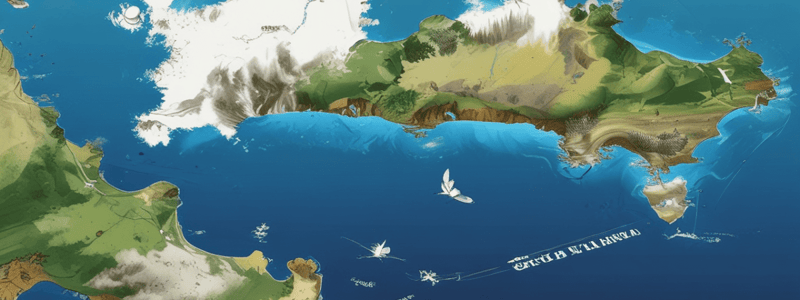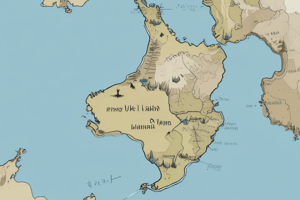Podcast
Questions and Answers
Which climatic condition makes the North Island more suitable for agriculture?
Which climatic condition makes the North Island more suitable for agriculture?
- Higher volcanic activity
- Drier climate
- Even rainfall distribution (correct)
- Flatter terrain (correct)
What has contributed to the fertile soils in the North Island?
What has contributed to the fertile soils in the North Island?
- High rainfall rate
- Presence of dormant volcanic activity
- Proximity to continental landmasses
- Active volcanism (correct)
What is the largest export of New Zealand based on livestock?
What is the largest export of New Zealand based on livestock?
- Sheep products (correct)
- Poultry goods
- Dairy products
- Beef products
How much of New Zealand's land is classified as arable?
How much of New Zealand's land is classified as arable?
What percentage of New Zealand's population was foreign-born as of 2022?
What percentage of New Zealand's population was foreign-born as of 2022?
What issue has resulted from Auckland's population growth?
What issue has resulted from Auckland's population growth?
What has historically impacted New Zealand's population growth rates?
What has historically impacted New Zealand's population growth rates?
What is the primary driver of New Zealand's economy amidst demographic changes?
What is the primary driver of New Zealand's economy amidst demographic changes?
What is the approximate population density of New Zealand?
What is the approximate population density of New Zealand?
Which island in New Zealand has the majority of the population?
Which island in New Zealand has the majority of the population?
Which factor contributed to the initial European settlement in the South Island?
Which factor contributed to the initial European settlement in the South Island?
What is a significant geographic feature on the South Island that affects development?
What is a significant geographic feature on the South Island that affects development?
How has the Māori population in New Zealand changed from initial settlement to 1890?
How has the Māori population in New Zealand changed from initial settlement to 1890?
What percentage of New Zealand's population lives in Auckland?
What percentage of New Zealand's population lives in Auckland?
Which of these factors is true about New Zealand's climate?
Which of these factors is true about New Zealand's climate?
Which side of the South Island experiences heavy rainfall?
Which side of the South Island experiences heavy rainfall?
Flashcards are hidden until you start studying
Study Notes
Geography and Population of New Zealand
- Nearly 80% of New Zealand's land area is uninhabited by humans, despite its favorable climate.
- North Island and South Island are the 12th and 14th largest islands globally, larger than the UK and comparable to the U.S. East Coast.
- New Zealand's climate is oceanic and temperate, similar to the UK, characterized by warm summers and mild winters.
Population Density Comparisons
- New Zealand's population is around 5 million, significantly less than the UK's 69 million, resulting in a population density of only 18 people per square kilometer.
- The UK’s population density is approximately 281 people per square kilometer, making it 15 times denser than New Zealand.
Regional Population Distribution
- More than three-quarters of New Zealand's population resides on the North Island, with Auckland alone housing about 37% of all New Zealanders.
- The South Island is much less populated, with extremely low density recorded at about 5.4 people per square kilometer outside urban areas.
Historical Context
- New Zealand was one of the last habitable landmasses discovered by humans, with Polynesian settlers arriving around the 13th century.
- The indigenous Māori population initially numbered around 200,000 but dropped to about 40,000 by 1890 due to colonization impacts.
Settlement Patterns
- Initial European settlers favored the South Island, primarily for opportunities linked to gold discovery, as the North Island had a larger Māori population.
- By the 20th century, the North Island regained its population majority.
Geographic Challenges
- The South Island features the Southern Alps, a major mountain range that complicates development due to rugged terrain and lower accessibility.
- The western side of the South Island receives heavy rainfall, while the eastern side has a rain shadow effect leading to arid conditions.
Climatic Conditions
- The North Island has more even rainfall distribution, flatter land, and is warmer, making it more suitable for agriculture and sustaining larger populations.
- Active volcanism contributes to fertile soils in the North Island, absent in the South Island due to its dormant volcanic activity.
Volcanic Activity
- New Zealand has experienced 13 significant volcanic eruptions in the last 1800 years, with only four minor eruptions in the North Island over the past century.
Data Comparison with Other Regions
- Other islands with higher populations like Java and Honshu have been settled for thousands of years due to their proximity to continental landmasses, contrasting with New Zealand's late discovery and settlement.### Geography and Agriculture in New Zealand
- Volcanic ash from Indonesian and Japanese islands enriches soils, making them more fertile than New Zealand's largely dormant soil.
- New Zealand has less than 2% of its land mass classified as arable, comparable to arid countries like Jordan and Somalia.
- Despite low arable land, the temperate climate and available water contribute to a robust grazing industry.
Agricultural Industry Dynamics
- New Zealand has nearly 27 million sheep, outnumbering its population of 5.1 million, making it the largest exporter of sheep products globally.
- Dairy products, driven by a cow population more than twice that of humans, constitute New Zealand's largest export.
- Over 55% of New Zealand's total land is dedicated to agriculture, primarily livestock, limiting rural settlement and land use.
Population Growth and Immigration
- Historically low birth rates, recently dipping to 1.8 children per woman, have impacted population growth.
- Significant population growth since the 19th century has primarily stemmed from immigration, particularly after World War II when racist policies were relaxed.
- As of 2022, 27% of New Zealand's population is foreign-born, with significant immigration from Asia.
Urbanization and Housing Challenges
- Auckland has seen over half of New Zealand's population growth from 1996 to 2016, sparking concerns over sustainability and housing affordability.
- By 2022, average house prices in Auckland reached over 1.1 million USD, presenting a stark contrast to the average annual salary of 44,000 USD.
- Housing prices in Auckland are unaffordable, costing 25 years of an average salary, complicating living conditions for residents.
Future Outlook
- New Zealand’s immigration policies are rooted in understanding ecological limitations, balancing population growth with available resources.
- The country's reliance on animal agriculture will likely continue as a primary export driver and economic pillar amidst demographic changes.
Geography and Population of New Zealand
- Nearly 80% of New Zealand's land is uninhabited, benefiting from a favorable oceanic climate.
- The North Island ranks as the 12th largest island and the South Island as the 14th, both larger than the UK and comparable to the U.S. East Coast.
- New Zealand experiences a temperate climate with warm summers and mild winters, similar to the climate in the UK.
Population Density Comparisons
- The population of New Zealand is around 5 million, significantly lower than the UK's 69 million, resulting in a density of 18 people per square kilometer.
- The UK's population density is approximately 281 people per square kilometer, making it 15 times denser than New Zealand.
Regional Population Distribution
- Over 75% of New Zealanders live on the North Island, with Auckland housing about 37% of the total population.
- The South Island has a much lower population density, with only about 5.4 people per square kilometer outside urban areas.
Historical Context
- New Zealand was among the last habitable places discovered by humans, with Polynesian settlers arriving around the 13th century.
- The indigenous Māori population decreased from approximately 200,000 to about 40,000 by 1890 due to colonization effects.
Settlement Patterns
- Initial European settlers preferred the South Island due to gold opportunities, as the North Island had a larger Māori presence.
- By the 20th century, the North Island regained population majority.
Geographic Challenges
- The Southern Alps on the South Island hinder development due to their rugged terrain.
- The western side of the South Island experiences heavy rainfall, while the eastern side is arid due to a rain shadow effect.
Climatic Conditions
- The North Island has even rainfall distribution and warmer temperatures, supporting agriculture and larger populations.
- Active volcanism on the North Island provides fertile soils, unlike the dormant volcanic activity on the South Island.
Volcanic Activity
- New Zealand has witnessed 13 significant volcanic eruptions in the past 1800 years, with only four minor eruptions in the North Island in the last century.
Data Comparison with Other Regions
- Islands such as Java and Honshu are densely populated due to early settlements; New Zealand's discovery and settlement occurred much later.
Geography and Agriculture in New Zealand
- Volcanic ash from Indonesian and Japanese islands enhances soil fertility more than New Zealand's dormant soil.
- Less than 2% of New Zealand’s land is arable, comparable to arid nations like Jordan and Somalia.
- Despite limited arable land, its temperate climate and water availability support a vigorous grazing industry.
Agricultural Industry Dynamics
- New Zealand has nearly 27 million sheep, outpacing its human population, making it the world's largest sheep product exporter.
- Dairy products, supported by a cow population more than double that of humans, represent New Zealand's largest export sector.
- Over 55% of land in New Zealand is dedicated to agriculture, predominantly livestock, influencing rural settlement patterns.
Population Growth and Immigration
- Low birth rates, currently at 1.8 children per woman, have affected overall population growth.
- Significant growth since the 19th century has largely resulted from immigration, especially post-World War II after the easing of racist policies.
- By 2022, 27% of New Zealand’s population was foreign-born, with substantial immigration from Asia.
Urbanization and Housing Challenges
- Auckland has accounted for more than half of New Zealand's population growth from 1996 to 2016, raising sustainability and housing concerns.
- By 2022, average house prices in Auckland surpassed 1.1 million USD, starkly contrasting the average annual salary of 44,000 USD.
- Housing affordability in Auckland requires 25 years of an average salary, complicating living conditions.
Future Outlook
- New Zealand's immigration policies reflect an understanding of ecological limits, seeking to balance population growth with resource availability.
- The reliance on animal agriculture is expected to continue as a key economic driver amidst demographic shifts.
Studying That Suits You
Use AI to generate personalized quizzes and flashcards to suit your learning preferences.




